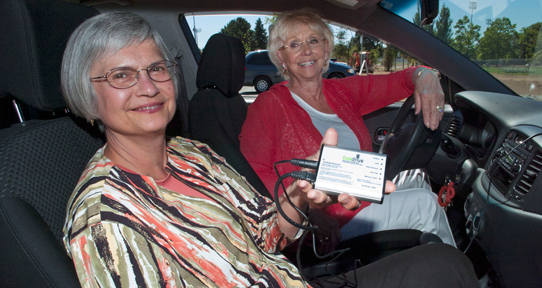Keeping you behind the wheel—safely

Tests currently used by doctors to assess a senior's ability to keep driving need to be improved, a long-term study of older drivers is revealing.
The currently available guidelines for physicians are not doing a very good job of identifying people at risk,says Dr. Holly Tuokko, a psychologist with UVic's Centre on Aging. We need a better set of tools.
Tuokko is part of Candrive, a pan-Canadian research study aimed at improving the safety and quality of life for older drivers. The study is following the progress of 928 drivers aged 70 and older in seven Canadian cities, including 125 in Victoria'as well as about 300 participants in Melbourne, Australia, and New Zealand.
The study, which is funded by the Canadian Institutes of Health Research, has already collected five years of data from driver participants, and recently received $1.9 million in additional funding for a three-year extension.
Highest crash rate per mile
Statistics show that although older drivers make up almost 14 per cent of BC's driving population, they're responsible for only 9.2 per cent of accidents and collisions causing death. But when crash rates are adjusted for distance driven, drivers over 70 have the highest motor vehicle crash rate per mile of all age groups.
On the flip side of the coin, loss of driving privileges can increase dependency on family and community support, and contribute to loss of self-esteem.
Candrive is asking questions such as: How do seniors get assessed for their driving ability? What are their attitudes toward driving as they age and health issues emerge? What motivates them to change their behaviour behind the wheel? And what factors affect their decision to stop driving?
Current physician assessments of seniors rely on what's called a "mini-mental state" examination, which asks seniors cognitive questions such as: What day is it? Can you remember these three words? Can you draw this diagram?
"It's looking at how people reason, think and remember," says Tuokko. "Obviously, if you do poorly on this test, you may drive poorly. But there's a lot of grey area in there."
Cognition is not the only reason why an older person may have difficulty on the road, she notes. They may not be able to move their bodies with sufficient flexibility or not know where their foot is in space, so they hit the gas instead of the brake.
"Those kinds of issues are not typically on the radar for general physicians who are trained to identify a medical problem but have little or no training on whether that problem can affect driving."
The result, she says, is that some seniors who should be going for driver evaluation tests are being missed, while others are being sent for tests unnecessarily.
Attitudes predict behaviour, not health
One of the main goals of Candrive is to develop an easy-to-use clinical screening tool that will allow family practitioners to assess medical fitness to drive in older adults.
To do this, the research team is collecting evidence-based information on the kinds of predictive tests doctors can do in their offices, gathering data on violations and crashes, and tracking the 928 Canadian drivers over time with annual assessments and an in-car digital tracking device.
The device is a small box that plugs in underneath the dashboard and records when and where they're driving. There’s also a GPS unit on the dash so that the study team can draw maps based on data such as route, stops and speed.
The results can be revealing, says Tuokko. “What people say they’re doing and what they actually do don’t always line up. Given that most doctors depend on patients to self-report their symptoms, these discrepancies are a little surprising.”
Tuokko’s own focus within the Candrive study is on the attitudes and beliefs of seniors about their driving, and how those change over time. Does the person feel good about driving? Or does he or she drive for others? Do they restrict their driving under certain conditions? And what process do people use to stop driving?
“We’re finding that it’s their attitude that’s predicting their behaviour, not so much their health status,” says Tuokko.
“We’re developing a model of behaviour change to determine if the more conditions under which seniors prefer not to drive, the closer they are to stopping,” she says. “Those conditions are directly related to how they feel about their driving.”
The ultimate goal is to encourage drivers to self-reflect and self-regulate, rather than leaving it until someone takes their license away, says Tuokko. “It’s much better for them mentally and physically if they make that decision on their own.”
The Candrive results are already of interest to a wide range of stakeholders, including the motor vehicle departments in all provinces, insurance agencies, the medical community, public health agencies, geriatric organizations, psychologists, opthalmologists, occupational therapists and physiotherapists.
Mostly, Tuokko hopes her work will lead to increased safety for seniors who drive, and an awareness that older drivers are not necessarily bad ones. “Age is equated with poor driving but I don’t believe that’s appropriate,” says Tuokko. “The focus should be on safety, not driver age.”
For more information on Candrive visit candrive.ca.
Article by Val Shore. Originally published in UVic knowlEDGE.
